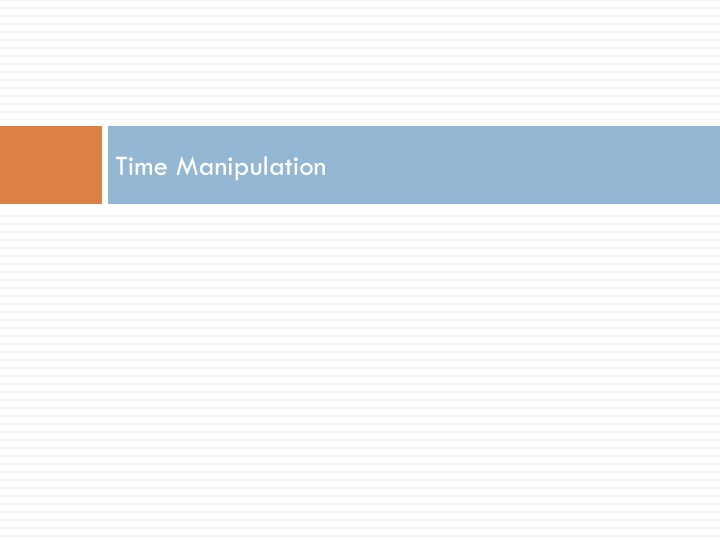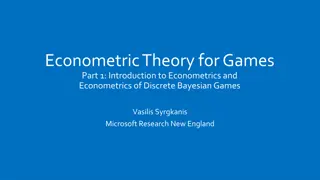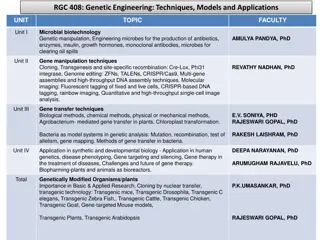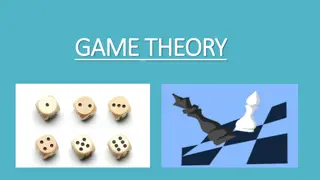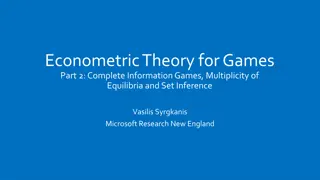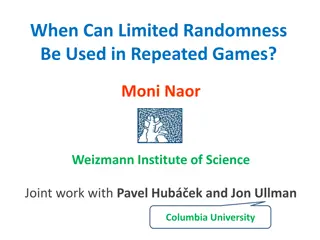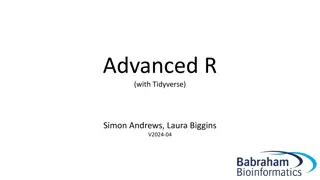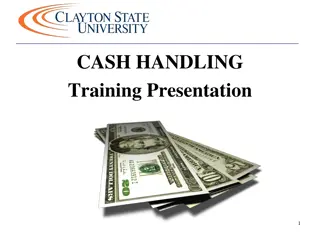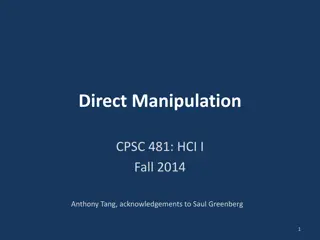Efficient Techniques for Handling Time Manipulation in Games
The game states rendered at the clients may differ due to latency, causing unfairness. Learn about Time Delay and Time Warp techniques to mitigate this issue. Playout delay and time delay mechanisms are explained, along with their impact on game latency and fairness.
Download Presentation

Please find below an Image/Link to download the presentation.
The content on the website is provided AS IS for your information and personal use only. It may not be sold, licensed, or shared on other websites without obtaining consent from the author.If you encounter any issues during the download, it is possible that the publisher has removed the file from their server.
You are allowed to download the files provided on this website for personal or commercial use, subject to the condition that they are used lawfully. All files are the property of their respective owners.
The content on the website is provided AS IS for your information and personal use only. It may not be sold, licensed, or shared on other websites without obtaining consent from the author.
E N D
Presentation Transcript
Time Manipulation The game states rendered at the clients are different because latency is dependent on the location of the client from the server and network state along different paths When the same response reaches players at different times, there is an unfairness factor introduced in the game. Two efficient techniques for handling this manipulation are Time Delay or Playout Delay and Time Warp or Roll Back.
Play Out Delay in Multi Media Playout delay is a mechanism used in the audio and video worlds to smooth out network delays and jitter. A smoothing buffer is used to store several frames of data at a receiver and playout of the data lags the original time of the event. Size of buffer (i.e., delay/lag): The larger the smoothing buffer, the better the output (less jerkiness) but impacts interactivity as one user lags the other. Too large: can be very annoying, e.g., in audio conversations -> users talk through each other. Too small: may not be able to hide jitter.
Time Delay C/S Model S Side An artificial delay is introduced when processing player updates to equalize latency at the server. Received actions placed in a buffer and processed with a short delay. Delay chosen to allow all clients actions to arrive at S Instead of processing a nearby client s action upon receiving it, the server purposely introduces a delay in processing the request, allowing more time for remote clients actions to the current game state to arrive. The game state updates sent by the server can also be delayed in being sent out, send the response to a client that is far away before sending the response to a client that is closer This technique ensures that all clients have the same effective latency in the game world at the server consistent game view
Time Delay C/S Model C Side The clients themselves can introduce buffering to equalize latency client that is closer to the server delays processing of the server response while client which is further away processes the response immediately. Used in peer to peer (P2P), where each client waits for all other clients actions called bucket synchronization. Client side playout delay is sometimes referred to as a form of conservative simulation.
In P2P: Bucket Synchronization t0 t1 t2 t3 t4 EA1 ClientA EB1 EB2 ClientB EC1 EC2 ClientC Interval (T ) Playout delay (T )
Impact of Time Delay/Play out Delay Buffering of received data works towards equalizing the latency among various clients, BUT it can make the game play less responsive. Size of buffer (i.e., delay/lag): The larger the smoothing buffer, the better the output (consistent state space, fairer) but impacts interactivity/responsiveness as client lags the player. Too large: can be very annoying. Too small: may not be able to counter the network latency/jitter.
Time Warp or Roll Back Server rolls back or time warps the events in a game to a time when a far away or delayed client action took place and was sent. For example: player 1 shoots at player 2 at time t0, the time the message arrives at the server is t3, player 2 moved at time t1 which was received at the server at time t2 t0 < t1 < t2 < t3 -> Server concludes that player 2 moved at t2 and was not shot by player 1 BUT when server checks all the timestamps it realizes the discrepancy. It uses the time warp technique and rolls back the events it had processed, i.e., player 2 moved at t2 and NOT dead IS WRONG INSTEAD player 2 DEAD since player 1 acted earlier i.e., at t0 In this case, the server will determine that the older event (shooting by player 1) has a bearing on a subsequent event (death of player 2. Server changes the OUTCOME to make the global game state consistent/accurate -> server will determine that player 1 hit and killed player 2, as the opponent s movement at time t1 was invalid since it occurred after t0 even though it was received at time t2 which was before time t3
Time Warp Contd Figure shows a screenshot of a Half Life 2 server. Round-trip latency to the client - 200 ms, meaning the user s commands are executed 100 ms screenshot. Red boxes show the target position on the client where it was 100 ms ago. Since then, the target moved to the left while the user s travelling over the network to the server. Actual soldier graphic. When the user command arrives at the server, the server rolls back time (time warp) to put the target in the position it was at the time the user made the shot, indicated by the blue boxes. The server determines there was a hit (the clients see blood from the wounds). before the command was
Time Warp Shortcomings Disruptive gameplay Suppose a player places the cross-hairs of a gun on an opponent and fires. But message was delayed. In the meantime the opponent moved, perhaps even around a corner and out of sight. The server, using time warp, will ultimately determine this is a hit . Inconsistency: It will seem to the opponent that the bullets actually went around the corner!!!!!
Time Warp contd General Algorithm for the Server: Receive packet from client Extract information (user input) Elapsed time = current time latency to client Rollback all events in reverse order to current time elapsed time Execute user command Repeat all events in order, updating any clients that are affected Repeat For Time Warp it is critical to have an accurate measurement of the latency between a client and a server so that the game time can be rolled back the exact amount of time.
Interpolation Extrapolation is tricky, so why not just interpolate? Just delay all received information until there are two messages, and interpolate between them Only adds delay equal to the time between sending packets
One Frame Delay and Interpolation t1 P1 t2 P2 P3 t3 P4 t4 Sender Receiver
Two Frame Delay and Interpolation t0 t1 t2 t3 P0 P1 P2 P3 Interpolate P0 P1 Playout delay
Non-Linear Interpolation Need to consider several aspects Object movement is not linear, so could use quadratic, cubic, etc. by keeping three or more updates
Two frame Delay and Non-Linear Interpolation t1 P1 P1, P2 and P3 movement t2 P2 P3 t3 P2, P3 and P4 movement P4 t4 t5 t6 Sender Receiver
Accommodating for Furthest Client - Playout Delay t0 t1 t2 t3 Sender P0 P1 P2 P3 ClientA ClientB Interpolate P0 P1 Maximum latency Playout delay
Local Perception and Playout Delay So far assumed that events should be displayed asap on clients. However, with moving objects, when they are further away, they move slower, but as they get closer they move faster. So objects closer should have low playout delay and objects far away should have longer playout delay.
Perception Filters In these techniques, the progress of time is altered at different clients Clients choose to predict ahead or delay playout depending on the meaning and their expected interaction
Using P2P Pong as an example The ball s motion is predictable. Each client extrapolates the ball s position, using their own physics engine (on local device) or motion prediction algorithm. Each client is programmed only to alter the ball s trajectory on impact. The bouncing of the ball off the paddle is sent via a message to the opponent. This transmission could take some time: Tnetwork. So opponent will react later than perceived by the player and the ball will appear as if it flew by the paddle instead of being hit.
X=0 X=1 X=0 X=1 Client A at X=0 Client B at X=1 ClientB ClientA
1.0 x position of ball as seen from ClientA x position x position of ball as seen from ClientB 1.0 2.0 3.0 4.0 Time b) Both clients view of the ball x position without using temporal corrections
Velocity of Ball on Client A When ball leaves the paddle, the ball needs to be slowed down on the client s machine taking into account the network lag. The distance between two paddles is assumed to be one unit, A at x=0, and B at x=1. Vx= velocity of the ball, secs/unit. So 1/Vx = time in units to cross the Pong board. Actual time it takes to cross is T = Tnetwork + 1/Vx So velocity according to A is: V = 1/T = Vx/(1 + (Tnetwork x Vx) - SLOWER
Velocity of Ball on Client B When the ball comes back again, it needs to be sped up to makeup for the lost time when traveling away. V = Vx/(1 - (Tnetwork x Vx) So velocity according to B is FASTER Round trip to cross = 2/Vx . Doesn t change. The network lag changes the perception with speed.
1.0 x position 2. 0 3.0 4.0 1.0 Time
1.0 x position of ball as seen from ClientB x position x position of ball as seen from ClientA 2.0 3.0 4.0 1.0 Time a) Both clients view of the ball x position using temporal corrections
1.0 x position of ball as seen from ClientA x position x position of ball as seen from ClientB 2.0 3.0 4.0 1.0 Time b) Both clients view of the ball x position without using temporal corrections
Latency Compensation and Cheating The anonymity factor in online games means there are many opportunities for cheating. Some of the latency compensation techniques while reducing the effect of latency introduce more opportunities for cheating.
Latency Compensation and Cheating (Cont.) Cheating Opportunity Examples: With opponent prediction there is no need for a server! But that can only work in trusted environments where players know each other. With time warp, a client could interfere with measurements about round-trip time, making the server believe the client is further away than it actually is. This would allow the client to respond to events that, in essence, happened in the past and hence giving unfair advantage. With time delay, a client with slow reflexes could claim a higher latency than it actually has, causing a large time delay at the server, thus neutralizing the better reflexes that opponents may have. Server Control: For massive online gaming there is a need of an authoritative server which confirms or refutes inappropriate client requests and actions and also keeps track of the exact time delay between the server and each client.
